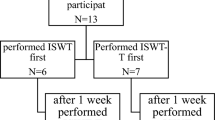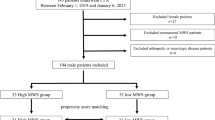Abstract
Background
The incremental shuttle walk test (ISWT) is a standardised assessment for cardiac rehabilitation. Three studies have reported oxygen costs (VO2)/metabolic equivalents (METs) of the ISWT. In spite of classic representations from these studies graphically showing curvilinear VO2 responses to incremented walking speeds, linear regression techniques (also used by the American College of Sports Medicine [ACSM]) have been used to estimate VO2.
Purpose
The two main aims of this study were to (i) resolve currently reported discrepancies in the ISWT VO2-walking speed relationship, and (ii) derive an appropriate VO2 versus walking speed regression equation.
Methods
VO2 was measured continuously during an ISWT in 32 coronary heart disease [cardiac] rehabilitation (CHD-CR) participants and 30 age-matched controls.
Results
Both CHD-CR and control group VO2 responses were curvilinear in nature. For CHD-CR VO2 = 4.4e0.23 × walkingspeed (km/h). The integrated area under the curve (iAUC) VO2 across nine ISWT stages was greater in the CHD-CR group versus the control group (p < 0.001): CHD-CR = 423 (±86) ml·kg−1·min−1·km·h−1; control = 316 (±52) ml·kg−1·min−1·km·h−1.
Conclusions
CHD-CR group vs. control VO2 was up to 30 % greater at higher ISWT stages. The curvilinear nature of VO2 responses during the ISWT concur with classic studies reported over 100 years. VO2 estimates for walking using linear regression models (including the ACSM) clearly underestimate values in healthy and CHD-CR participants, and this study provides a resolution to this when the ISWT is used for CHD-CR populations.





Similar content being viewed by others
References
Singh SJ, et al. Development of a shuttle walking test of disability in patients with chronic airways obstruction. Thorax. 1992;47(12):1019–24.
Parreira VF, et al. Measurement properties of the incremental shuttle walk test. A systematic review. Chest. 2014;145(6):1357–69.
Ramsbottom R, Brewer J, Williams C. A progressive shuttle run test to estimate maximal oxygen uptake. Br J Sports Med. 1988;22(4):141–4.
Tobin D, Thow MK. The 10 m shuttle walk test with Holter monitoring: an objective outcome measure for cardiac rehabilitation. Coron Health Care. 1999;3:3–17.
Jolly K, et al. Reproducibility and safety of the incremental shuttle walking test for cardiac rehabilitation. Int J Cardiol. 2008;125(1):144–5.
British Association for Cardiovascular Prevention and Rehabilitation. A practical approach to exercise and physical activity in the prevention and management of cardiovascular disease. London: British Association for Cardiovascular Prevention and Rehabilitation; 2014.
British Heart Foundation. National audit for cardiac rehabilitation. British Heart Foundation, York University; 2015.
American Association of Cardiovascular and Pulmonary Rehabilitation. Guidelines for cardiac rehabilitation and secondary prevention programs. 5th ed. with web resource. Champaign: Human Kinetics; 2013.
American College of Sports Medicine. ACSM’s guidelines for exercise testing and prescription. Baltimore: Lippincott, Williams and Wilkins; 2013.
Sandercock GR, Brodie DA. The use of heart rate variability measures to assess autonomic control during exercise. Scand J Med Sci Sports. 2006;16(5):302–13.
Association of Chartered Physiotherapists in Cardiac Rehabilition. Standards for physical activity and exercise in the cardiac population. London: Association of Chartered Physiotherapists in Cardiac Rehabilitation; 2015.
Almodhy M, et al. Pilot investigation of the oxygen demands and metabolic cost of incremental shuttle walking and treadmill walking in patients with cardiovascular disease. BMJ Open. 2014;4(9):e005216.
Sandercock GR, et al. Cardiorespiratory fitness changes in patients receiving comprehensive outpatient cardiac rehabilitation in the UK: a multicentre study. Heart. 2013;99(11):785–90.
Woolf-May K, Ferrett D. Metabolic equivalents during the 10-m shuttle walking test for post-myocardial infarction patients. Br J Sports Med. 2008;42(1):36–41 (discussion 41).
Woolf-May K, Meadows S. Exploring adaptations to the modified shuttle walking test. BMJ Open. 2013;3(5) (pii:e002821).
Douglas CG, Haldane JS. The capacity of the air passages under varying physiological conditions. J Physiol. 1912;45(4):235–8.
Passmore R, Durnin JV. Human energy expenditure. Physiol Rev. 1955;35(4):801–40.
Margaria R, et al. Energy cost of running. J Appl Physiol. 1963;18:367–70.
Menier DR, Pugh LG. The relation of oxygen intake and velocity of walking and running, in competition walkers. J Physiol. 1968;197(3):717–21.
Falls HB, Humphrey LD. Energy cost of running and walking in young women. Med Sci Sports. 1976;8(1):9–13.
Dill DB. Oxygen used in horizontal and grade walking and running on the treadmill. J Appl Physiol. 1965;20:19–22.
Naughton J, Nagle F. Peak oxygen intake during physical fitness program for middle-aged men: measurement of changes by laboratory and field testing. JAMA. 1965;191:899–901.
McArdle DW, Katch FI, Katch VL. Exercise physiology: nutrition, energy, and human performance. 8th ed. Baltimore: Lippincott Williams and Wilkins; 2014.
Su SW, et al. Oxygen uptake estimation in humans during exercise using a Hammerstein model. Ann Biomed Eng. 2007;35(11):1898–906.
Buckley JP, Furze G, Doherty P, Speck L, Connolly S, Hinton S, British Association for Cardiovascular Prevention and Rehabilitation, et al. BACPR scientific statement: British standards and core components for cardiovascular disease prevention and rehabilitation. Heart. 2013;99(15):1069–71.
National Institute for Health and Care Excellence. MI—secondary prevention: secondary prevention in primary and secondary care for patients following a myocardial infarction. NICE guidelines CG172. London: National Institute for Health and Care Excellence; 2013.
British Association for Cardiovascular Prevention and Rehabilitation. Standards and core components of cardiovascular disease prevention and rehabilitation. 2nd ed. London: British Association for Cardiovascular Prevention and Rehabilitation; 2012.
Leger L, Mercier D. Gross energy cost of horizontal treadmill and track running. Sports Med. 1984;1(4):270–7.
Borg G. Borg’s perceived exertion and pain scales. Champaign: Human Kinetics; 1998.
Ainsworth BE, et al. 2011 compendium of physical activities: a second update of codes and MET values. Med Sci Sports Exerc. 2011;43(8):1575–81.
Buckley JP, et al. Standing-based office work shows encouraging signs of attenuating post-prandial glycaemic excursion. Occup Environ Med. 2014;71(2):109–11.
Levine JA. Non-exercise activity thermogenesis (NEAT). Best Pract Res Clin Endocrinol Metab. 2002;16(4):679–702.
Savage PD, Toth MJ, Ades PA. A re-examination of the metabolic equivalent concept in individuals with coronary heart disease. J Cardiopulm Rehabil Prev. 2007;27(3):143–8.
Pepera G, et al. Predictors of shuttle walking test performance in patients with cardiovascular disease. Physiotherapy. 2013;99(4):317–22.
Koike A, Hiroe M, Marumo F. Delayed kinetics of oxygen uptake during recovery after exercise in cardiac patients. Med Sci Sports Exerc. 1998;30(2):185–9.
Tajima A, et al. Oxygen uptake kinetics during and after exercise are useful markers of coronary artery disease in patients with exercise electrocardiography suggesting myocardial ischemia. Circ J. 2009;73(10):1864–70.
Dodd S, et al. Effects of beta-adrenergic blockade on ventilation and gas exchange during the rest to work transition. Aviat Space Environ Med. 1988;59(3):255–8.
Kowalchuk JM, Hughson RL. Effect of beta-adrenergic blockade on VO2 kinetics during pseudorandom binary sequence exercise. Eur J Appl Physiol Occup Physiol. 1990;60(5):365–9.
Poole DC, Jones AM. Oxygen uptake kinetics. Compr Physiol. 2012;2(2):933–96.
Eynon N, et al. The effect of long-term beta-adrenergic receptor blockade on the oxygen delivery and extraction relationship in patients with coronary artery disease. J Cardiopulm Rehabil Prev. 2008;28(3):189–94.
Head A, Maxwell S, Kendall MJ. Exercise metabolism in healthy volunteers taking celiprolol, atenolol, and placebo. Br J Sports Med. 1997;31(2):120–5.
Gullestad L, et al. The effect of acute vs chronic treatment with beta-adrenoceptor blockade on exercise performance, haemodynamic and metabolic parameters in healthy men and women. Br J Clin Pharmacol. 1996;41(1):57–67.
Juhlin-Dannfelt A. Beta-adrenoceptor blockade and exercise: effects on endurance and physical training. Acta Med Scand Suppl. 1983;672:49–54.
Acknowledgments
The authors are grateful to all patients who have volunteered for this study (at Colchester and Liverpool) and for the invaluable assistance of the cardiac rehabilitation professionals involved (Liverpool: Elaine Gossage, Zoe Evans and Adrian Roose).
Author information
Authors and Affiliations
Corresponding author
Ethics declarations
Funding
The authors are also grateful for the financial support of the Foundation for Science and Technology to Fernando M.F. Cardoso on this study, under Project No. SFRH/BD/86769/2012.
Conflict of interest
John P. Buckley, Fernando Cardoso, Stefan T. Birkett and Gavin G.R. Sandercock declare no conflicts of interest.
Informed consent
Informed consent was obtained from all individual participants included in the study.
Ethical approval
All procedures performed in studies involving human participants were in accordance with the ethical standards of the institutional and/or national research committee and with the 1964 Helsinki declaration and its later amendments or comparable ethical standards.
Rights and permissions
About this article
Cite this article
Buckley, J.P., Cardoso, F.M.F., Birkett, S.T. et al. Oxygen Costs of the Incremental Shuttle Walk Test in Cardiac Rehabilitation Participants: An Historical and Contemporary Analysis. Sports Med 46, 1953–1962 (2016). https://doi.org/10.1007/s40279-016-0521-1
Published:
Issue Date:
DOI: https://doi.org/10.1007/s40279-016-0521-1




